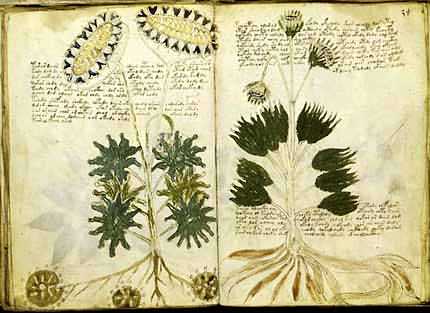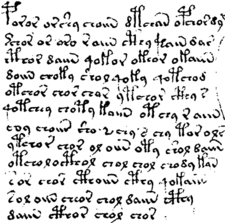Luigi Serafini (Rome, August 4, 1949) is an Italian artist.He is famous for his works unusual and vague, such as the Codex Seraphinianus (1981).Seraphim began his career as an architect. In 1981 he published the Codex Seraphinianus, which attracted the attention of Roland Barthes and the Italo Calvino wrote an essay that was published in the "Collection Sand" collection (Oscar Mondadori). The Codex Seraphinianus also inspired choreographer Philippe Decouflé. In 1983 it was the turn Pulcinellopedia (Small), a book designed as a suite of pencil drawings and short texts that completely mask Pulcinella.Serafini Besides being a painter, sculptor, potter, jewelry, etc., has made bold forays into the field of design, such as in 1981 with Ettore Sottsass and Memphis then clearly metalinguistic project of the impression, like a chair "Suspiral" and "Santa" for Sawaya & Moroni or glass and lamp for Artemide.In the cinema invented and designed the first poster of Federico Fellini's last film of The Voice of the Moon, with Roberto Benigni and Paolo Villaggio. In the theater has produced lighting, sets and costumes for "Jazz Calendar" Frederick Ashton's ballet La Scala. In 1999 he was a finalist for Best Production Design Award Ubu with "Ingredients for German tragedy" produced by the Piccolo Teatro of Milan.In the first picture there is a very dark with a police officer standing with his legs apart to see a bird out of the cage is placed in the earth on a black background.Since 2003, the station out of the new Mater Dei Naples Metro, there is a large polychrome bronze sculpture, "Carpe Diem", beginning with colored polyester floor with bas-reliefs, "Paradise pédestre."From May to June 2007 held at PAC (Pavilion of Contemporary Art in Milan) a "Show Ontological" titled "Luna Pac-Seraphim" which counted nearly 11,000 visitors in just 30 days.In July 2008, requiring the installation of wooden polychrome border "sans Frontières Balançoires" (Swings Without Borders) in Castasegna, along the Swiss-Italian border, after Chiavenna and the way to St Moritz. This structure allows limited dondolasi between the two countries and was recently acquired by the city in Switzerland.


Written kira2 1976 and 1978 by the Italian artist Luigi Serafini, is nothing if not deliberate creating something mysterious. The book is said to be an encyclopedia of the imaginary planet, complete with maps and drawings of plant and animal life. The most interesting, Serafini wrote a book in his hypothetical world. Entirely composed in a bizarre alphabet that is still yet to be translated even after intense study by linguists. Since the text itself is unreadable, the Codex has become the most famous works of art Serafini, which ranged from surreal and beautiful. One page describes the fruit that looks bloody, while others show fish shaped like a flying saucer. In one of the most famous picture books (this is already closing in most editions), a series of panels depicting a naked man and woman slowly turned into a crocodile.
Examples of text and images in the book Codex Seraphinianus:
This image may be plants

It may be a few instances ancient plants
or ancient animals

Some examples of animals and their parts

Can be interpreted as the origin of animals like strawberries

Ikan atau hewan air menyerupai mata

Murder by poison on the arrow or spear

People who have intercourse, they may fornicate then converted into a crocodile

They become crocodiles and go. It's like explaining the origin of crocodiles or punishment of adultery.

Some plants predators

Plants that can swim

Theories on the tools ", such as carts, bolts and locks.
Can also it is an animal.

That explanation seems to me, hehe ... But I could be wrong because I am not an expert in that field.
Possible Explanation of the experts:Theories abound as to what the actual secret of the Codex Seraphinianus, but Serafini has remained silent on the meaning of the book since its release in the early 80's.
2 Voynich ManuscriptVoynich Manuscript - History
No one knows for sure the origin of the manuscript. Based on the pictures in it, experts believe that the manuscript originated in Europe and is likely to come from the 15th century or 17th century AD.
Note that the first known ancient manuscript alludes comes from a letter alchemist named Georg Baresch addressed to Athanasius Kircher, a Jesuit scholar from Rome.
In his letter, Baresch Kircher for help to solve the meaning of the writings in the manuscript. But Kircher also could not solve the mystery. After the death of Baresch, ownership of the manuscript fell into the hands of Kircher and stored neatly in the library Collegio Romano. The manuscript is kept neatly in place until 250 years later.
 In
1912, the Collegio Romano in need of money decided to sell some ancient
manuscripts owned to the collector and that's when the Voynich got 30
of them, including the mysterious manuscript.
In
1912, the Collegio Romano in need of money decided to sell some ancient
manuscripts owned to the collector and that's when the Voynich got 30
of them, including the mysterious manuscript.Voynich Manuscript - Characteristics and Content
Although its size is quite small, only 7 times 5 inches. But it has a thickness of 240 manuscript pages. In every page we can find writings hands with letters that are not as well known as rough illustrations of plants, astrological diagrams and even a naked woman.
Manuscript contains 170,000 letters separated by a narrow space. Most of the letters were written with only one or two times a stroke of a pen. The researchers suspect that the number of different alphabet in the manuscript was only about 20-30 different letter. Remarkably, the alphabet used in the manuscript does not have a relationship with the languages that exist in ancient Europe.
Illustrations from drawings made in the manuscript, the researchers concluded that the manuscript contains the herbal notes, astronomy, biology, cosmology, and pharmacy prescriptions. But it remains a mystery.
Voynich Manuscript - effort to solve the mystery
 In
1921, a professor of philosophy from the University of Pennsylvania
named Willaim R Newbold claimed that in every character present in the
Voynich manuscript was a very smooth stroke of a pen that can only be
seen with a magnifying glass and form of ancient Greek letters.
In
1921, a professor of philosophy from the University of Pennsylvania
named Willaim R Newbold claimed that in every character present in the
Voynich manuscript was a very smooth stroke of a pen that can only be
seen with a magnifying glass and form of ancient Greek letters.Based on this assumption, Newbold concluded that the manuscript contains the findings of science and written in the 13th century scientist and philosopher Roger Bacon. A decade later, Newbold conclusion disputed by other scientists by saying that the fine scratches are just natural fraction of the ink used to write.
Newbold Enterprises is just the beginning of a long effort to solve this mystery.
In the 1940s, the amateur code breaker named Joseph M Feely and Leonell C Strong use Roman letters can be substituted into the Voynich character. From his research, Strong concluded that the manuscript was made by 16th-century British writer named Anthony Ascham that one of his works titled "A Little Herbal" was published in 1550.
Although the contents of the manuscripts has similarities with "A Little Herbal", but researchers can not track how Anthony Ascham could gain knowledge about kryptografi. Conclusion Strong eventually ignored by other researchers.
In 1945, the Mystery is delivered into the hands of the expert codebreaker who succeeded in decoding the Japanese army during World War II. This code-breaking team has never failed to crack any code offered. But they also failed to uncover the mystery of Voynich manuscript.
In 1978, a linguist named John Stojko claimed that the text contained in the Voynich manuscript written in Ukrainian real with all the vowels removed. However, with this method, the resulting translation does not seem to make sense. Such a sentence that reads: "Emptiness is that what Baby God's Eye is fighting for" not at all in accordance with the illustration that is on the page.
In 1987, a physicist named Leo Levitov declared the manuscript was produced by the Cathars, a heretical sect in medieval France. According to Levitov, the letter used is a mixture of many languages, the Netherlands, Germany and France ancient. Although it seems reasonable, but the translation is generated Levitov not also be reasonable when compared with the history or theology of the Cathars.
Sorry, this is just an opinion of mine. If there is a mistake I apologize ....
Leave me a comment to this post to make it better
Click here for this post in Indonesian version












Komentar ini telah dihapus oleh administrator blog.
BalasHapus